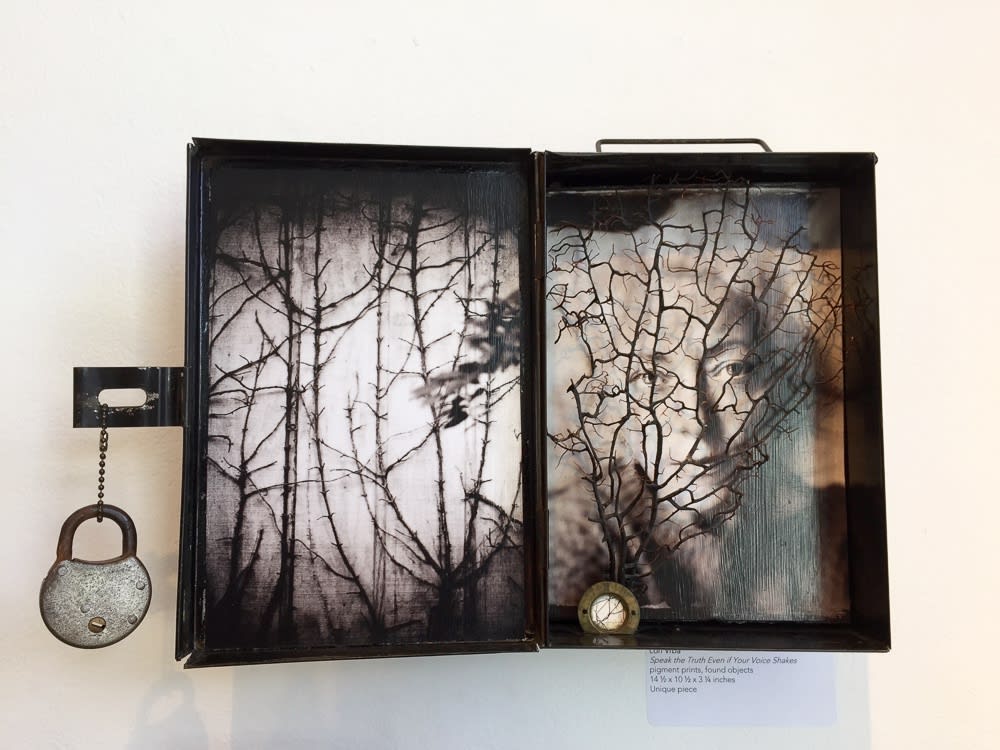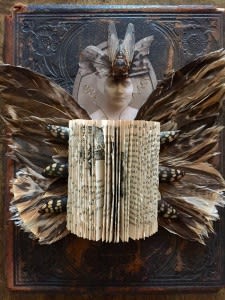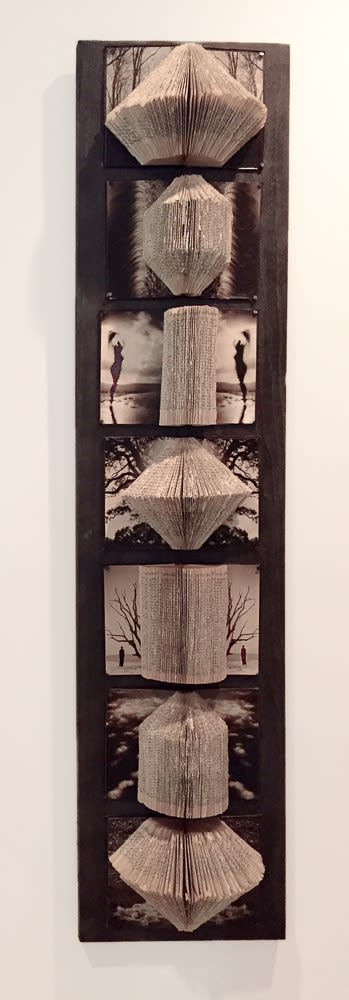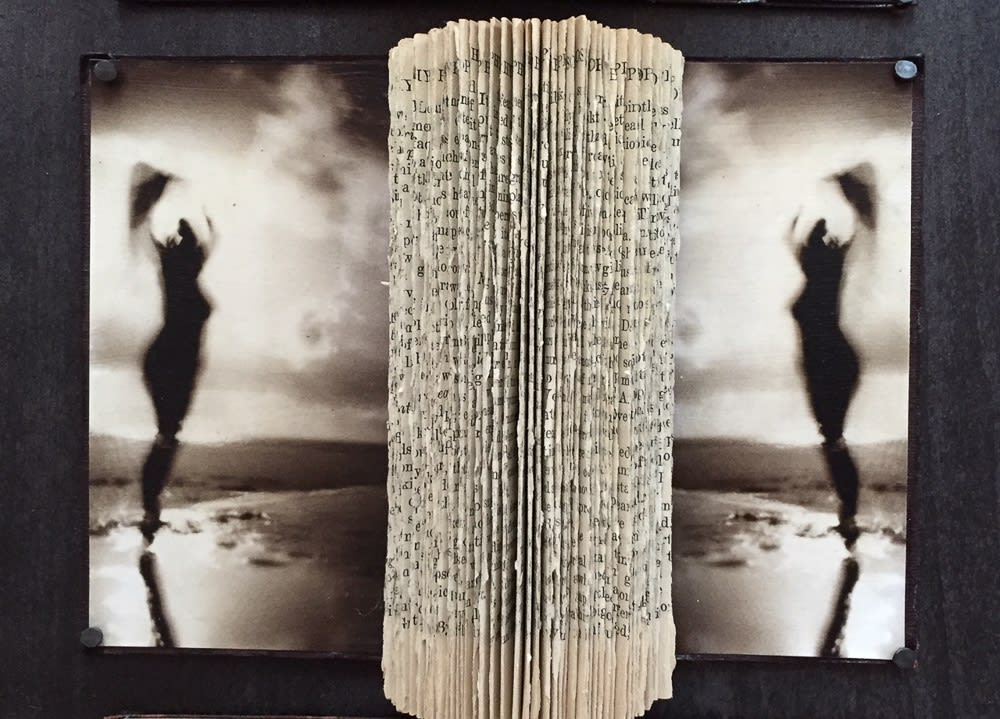
Lori Vrba’s current work, “Assemblage”, (1) revisits an important development in photography-based art. In the 1960s and 1970s, artists started to incorporate photography into works of art. Many of those artists did not start out as photographers, and many lacked any formal training in photography. Many were sculptors or painters.
A self-taught photographer, Lori began showing her work in 2009 and has continued to produce work ever since. She describes herself as “visually sensitive” from an early age in the back woods of Texas. (2) It is this inward felt sensitivity that form the foundation of many of her images. Much of her work is traditional black & white prints, beautifully done in the darkroom by her own hand every step of the way. She appreciates the accidents and serendipity of a moment photographing or developing in the darkroom. Lori, herself has said, “On a technical note…I am old school. I don’t use photoshop or any digital manipulation. I occasionally use my own prints as a “backdrop” or “stage” for a new image or story. All of my work is captured with medium format film. I process, print and tone in my home darkroom.” (3) However, what interests me most about her work is the combination of her photography with physical objects, other than prints on paper alone, to create a three dimensional work of art.
An appreciation of this trend in photography in the United States (4) began with what curator Peter C. Bunnell called “the first comprehensive survey of photographically formed images used in sculpture or fully dimensional manner…” (5). The exhibition “Photography into Sculpture” that he curated at the Museum of Modern Art (MOMA) in 1970 examined and brought together a number of then contemporary artists. The press release to the exhibition notes that while some of the artists are photographers, many started as painters and sculptors. One of the most well known practitioners of photo-assemblage might be Robert Heinecken. (6) His works were included both in Bunnell’s 1970 exhibition, and a later MOMA exhibit, “Object Matter” in 2014 , a retrospective of Heinecken’s work. (7) Lori’s works, for me, seem to follow this path 8, but in her own way, incorporating images into found objects or containers, rather than the new creation of the object into which the photography is embedded.
Despite Lori’s self-effacing tenacious way of speaking about her work, there is a deep set intuition as to how to assemble an image with objects. It began, she would say, with her assembling objects to tell a story for the “Drunken Poet’s Dream” (9) series. Struggling with her image of the “”Winged Victory” (10) , she woke up the next day and started assembling objects to match with images. These combinations then naturally evolved into three dimensional works. Every Assemblage includes some of her photography. The reason photography is included she says is identity. She views herself as a photographer, not a sculptor, or any other category of artist. A photographer. Each Assemblage is unique and Lori is focused intently on each piece. (11) Lori pays close attention to how each piece relates to another when put together for a show. She looks to embed in each piece a “look”, a style and “ethic”. (12)
Since she has always lived in the southern United States, Lori embraces and has come to terms with being a “Southerner”. This is her “ethic”, as well as a “romantic” (13) that looks to create a sentimental value into her images and objects. In her mind there is a “femininity” (14) in her images and is proud and shameless that her images carry a nostalgia and sensitivity. She feels her works include a perspective on family and our surroundings that is deeply embedded in her images that is uniquely “Southern”. Being “Southern” to her is the natural earthy quality visually presented to the viewer in the toning (15) she gives her black & white prints. Its the play of natural, found, objects that she places onto images of her children. Its the memories she holds growing up in the country living at the end of a long dirt road without a whole lot of people around that allowed her to find her inner artistic energy. All of this is the “romantic sense” that she feels washes over and into her images.

The series “Assemblage”, a combination of photography and “objects” put into a three-dimensional relief, is about problem solving. For her, its the visual presentation of an idea. Lori’s work “Speak the truth even if your voice shakes” contains a solemn self-portrait seen behind a thorn like cover of corral. The corral, according to her, is a visual blood system, something internal and core to life. It also appears as a barrier visually forcing the image to appear shattered. It is an image taken, she says, when she was tired, with no make-up on her face. An honest image of herself, Lori would say. To her, it’s symbolic of the things each person hides inside. The broken pieces within all of us. But the image is set into a folding hinged-case that can be opened or closed, just as any of us can be open with others, or closed. The lock hangs on the left as if ready to help lock away those hidden flaws, while actually creating a visual and physical balance to the image. Lori feels that much of her work deals with the struggle of our imperfections and loss.

Each of the “Assemblage” pieces forces us to look closer and to think about what we are really seeing. In “Ruins”, the face is not an image of a live child, but a stone statute. (16) The frame is the base of a column that is reminiscent of an antebellum home found in the deep south. The image of the child, to her, is what’s left behind of innocence and youth. It’s our own mortality. When I interviewed Lori, she related to me that her father died when he was 43 years old, and she was 20. (17) Her father was “heroic and special” to her. His passing at such an early age made Lori sensitive to her own mortality at a time when most of us feel eternal and immortal. It made her focus on living. Few other life experiences can bring as much meaning and life to an image, or sculpture, as knowing your own mortality. It’s that sense of wanting to live and feel life that is fundamental to appreciating her work.

Books are used in Vrba’s works with an intent to place us in time and place. The use of books is appropriate in her works, because in true Southern tradition, she is a story teller. “Izabelle” is an object built on a book cover. We don’t know the author or subject matter of the book; just that it is old and worn. Newer books, contemporary books, could have been used, but were not. Each page in the book is carefully folded by hand. (18) We don’t know the name of the child in the image, but Lori has given her the name “Izabelle”. As she works with old image of people gone-by, she gives them, in her mind, a new life and personality. For Lori, the use of the book is a metaphor for a life’s story. So the names given the objects are symbolic and not actual. But what is important to Lori is the sense that these once living persons live again in her sculptures. Many of her images include a Moth, or wings of a moth. (19) Moths are a recurring item in her works, within “Assemblage” and in her other photographs. Moths represent the ephemeral. Its fragility and flight. Its the embodiment of the “feminine” theme.

The “Assemblage” series takes on another chapter, so to speak with the evolving “Totem” works. It is as if one “object” like “Izablelle” or “Ruins” was not enough. The “Totems” are like several chapters in a book and are intriguing new pieces leveraging the art forms used by the indigenous people of the Pacific Northwest. According to an article in Wikipedia: “Totem poles are monumental sculptures carved on poles, posts, or pillars with symbols or figures .… Totem poles are not religious objects, but they do communicate important aspects of native culture. Carvings of animals and other characters typically represent characters or events in a story. The carvings may symbolize or commemorate cultural beliefs that recount familiar legends, clan lineages, or notable events. The poles may also serve as functional architectural features, welcome signs for village visitors, mortuary vessels for the remains of deceased ancestors, or as a means to publicly ridicule someone. Given the complexity and symbolic meanings of totem pole carvings, their placement and importance lies in the observer’s knowledge and connection to the meanings of the figures.“ Lori’s Totem pieces reflect this sense of culture and connectivity from one generation to the next.
Ever since the first photograph was taken in the 1830s, photos have been recorded on many materials. “Assemblage” is a creative and expressive step in that evolution. What is unique, is not only the historical reference relating back to the photographers exhibited by Peter Burnell at MOMA in 1970, but the incorporation now in the art form of another culture in her latest works. This work and images, and my conversations with Lori Vrba, as with other photographers I interview for this series of “Commentaries”, gives a new way to “see”, think and engage.

Notes:
- Each image created is a unique piece. See images of these works at http://www.lorivrba.com/assemblage/
- From comments made by Lori Vrba in an artist’s talk July 11, 2015 at Catherine Couturier Gallery in Houston, Texas
- See her introductory comments to her series “Drunken Poet’s Dream” at http://www.lorivrba.com/lori-vrba-drunken-poets-dream/
- The relationship of photography and sculpture, as opposed to its use “in” sculpture arguably finds its roots in France with sculpture Francois Willeme. See a very informative article in “Art Nadar”, “What is…Photosculpture?”, found at: http://artradarjournal.com/2015/02/27/what-is-photosculpture-art-radar-explains/
- See the Press Release at https://www.moma.org/momaorg/shared/pdfs/docs/press_archives/4438/releases/MOMA_1970_Jan-June_0035_36.pdf?2010. I strongly recommend an interested reader refer to this document as it contains a comprehensive list of the artists and their works in the exhibit.
- Robert Heinecken passed away in 2006. See an article about him in Wikipedia at : https://en.wikipedia.org/wiki/Robert_Heinecken
- See a description and link to images for the exhibition at: https://www.moma.org/visit/calendar/exhibitions/1419. See also an article by Ian Wallace, “What is Photosculpture? Explaining Art’s new Hybrid Obsession”, July 11, 2014, at ArtSpace.com at: http://www.artspace.com/magazine/interviews_features/what-is-photosculpture
- I say path because while there are not a large number of exhibits of this hybrid use of photography, there is a trail of growing interest. See the 2011 exhibit at the Cherry and Martin Gallery, “Photography and Sculpture/The Evolving Photographic Object” at: http://www.cherryandmartin.com/exhibitions/96 See also images at the Hauser & Wirth Gallery exhibit “The Photographic Object, 1970” held in 2014 at:http://www.hauserwirth.com/exhibitions/2222/the-photographic-object-1970/view/ . An Article discussing the Hauser & Wirth show by Karen Rosenberg of the New York Times “Using a Camera to Make More Than Memories”, July 17, 2014 is should also be read. http://www.nytimes.com/2014/07/18/arts/design/the-photographic-object-1970-revisits-a-renowned-show.html?_r=1
- The image can be seen on her website at http://www.lorivrba.com/lori-vrba-drunken-poets-dream/
- The first print of this image was titled “Pissed off Ballerina”, but after adding the wings, a different image was made and titled “Winged Victory”.
- Each installation of her work is a unique gathering of her images. No two exhibitions are the same. Elements of her different portfolios may appear in any one exhibition. But, her “Assemblage” work, because of its three dimensional sculptural character, can not be confused with any other portfolio of hers, or any other artist.
- The word “Ethic” is defined as “a system of moral stands or values”. Webster’s New World College Dictionary, 4th Edition.
- Lori describes herself as a “romantic”. The American Heritage Dictionary of the English Language, Fourth Edition, Houghton Mifflin Company, 2000, includes in the definition of “romantic” “Given to thoughts or feelings of romance”, but also “imaginative but impractical; visionary” and “Not based on fact, imaginary or fictitious”. All of which seem to imply to her works which are, in general very symbolic and fanciful, which I leave to the reader to look-up.
- We discussed what she meant by “feminine” as it applied to her images. I resorted to the definition supplied in Webster’s New World College Dictionary, 4th edition: “ gentleness, weakness, delicacy, or modesty”. Her argument was : Would a man make similar work?”
- “Photographic print toners are chemical solutions used to treat black-and-white prints after processing… Changes or enhances the image color to convey a mood or impression, from subtle to extraordinary.“ From a Kodak technical reference sheet at http://www.kodak.com/global/en/professional/support/techPubs/g23/g23.pdf
- Examine the image in Lori Vrba’s newly published photography book “The Moth Wing Diaries” , page 31,Daylight Books, 2015. Its a similar, but photographic, representation done in a beautifully different, but just as visually challenging, manner.
- This life event is shared with the permission of the artist.
- Later in this Commentary, see the image of a “Totem” from the “Assemblage” series where the pages are seen folded in a variety of different shapes.
- See the June 15, 2015 article in the “Houston Press” on Lori’s work at http://www.houstonpress.com/arts/photography-that-takes-flight-lori-vrba-exhibits-strength-and-vulnerability-in-the-moth-wing-diaries-7511727